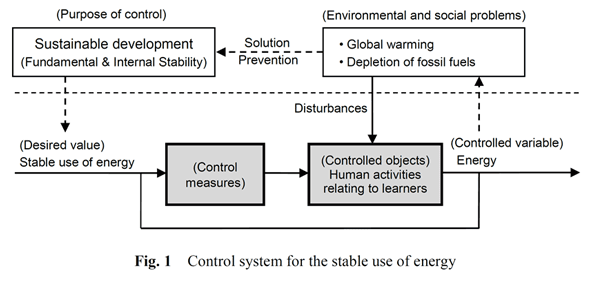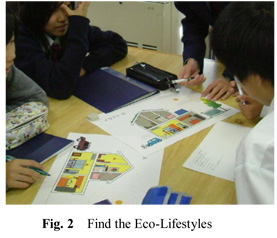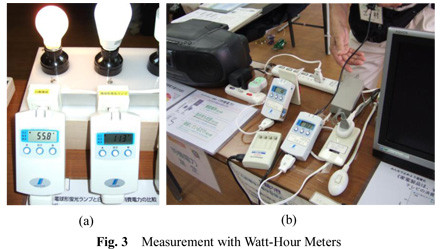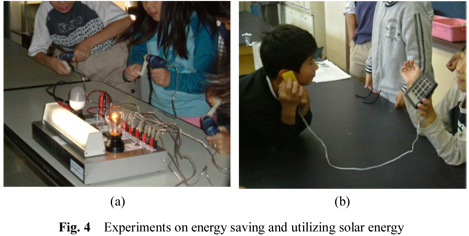Institute of Environmentology, Research and Education for Sustainability or Sustainable Development, Kazutoshi Fujihira
Energy Environmental Education Practice
Institute of Environmentology >> Energy Environmental Education Practice
Based on the methodology shown in ESD and Environmental Education Research, we have been producing programs of ESD (education for sustainable development) and putting them into practice at schools and regional communities. We especially concentrate on environmental education that is aimed at the stable use of energy.
Control system for the stable use of energy
Creating an educational program starts with showing a proper control system in accordance with a given educational theme. When the stable use of energy is the theme, we have regarded Fig. 1 as the control system. This control system shows that, in order to deal with 'global warming' and the 'depletion of fossil fuels,' 'energy' is identified as a controlled variable,' and the 'stable use of energy' is set as its desired value. The 'stable use of energy' means the use of energy that can achieve the purpose of control, especially the 'Fundamental Stability.' This is ultimately regarded as the state in which the energy used by learners can be met only by renewable energy such as solar energy. In addition, control measures are considered to be various 'changes in learners' behaviors' that promote energy saving and the utilization of renewable energy so that their energy needs can be met only by renewable energy.

Program components
Our life directly and indirectly involves using energy in different ways. Narrowing them down to the energy used in 'home' only, we have been producing educational programs for the stable use of energy and putting them into practice. The educational programs consist of several components from the following program components.
(1) Find the Eco-Lifestyles
In this activity, learners compare two contrasting homes: a home where energy is wasted (A)" and "a home where energy is used efficiently (B)."
Each step is easy. First, a pair of the illustrations is distributed to each group. Members of each group look for the differences between the two illustrations, thinking about and discussing the reasons why the amount of energy used in these two homes are significantly different from each other, while comparing these with their own homes (Fig. 2). 10 or 15 minutes later, representatives of the groups present the results of their discussions one by one. Examples are "While the lights in A are light bulbs, those in B are fluorescent lights," and "While washing in A is dried in the drier, that in B is dried in the sun." In addition, there are over 20 differences between A and B.

"Find the Eco-Lifestyles" relates to the 'elements increasing learners' capacity or motivation,' which are itemized in 'ESD and Environmental Education Research,' in the following way. "A home where energy is wasted (A)" corresponds to a common controlled variable for learners, whereas "a home where energy is used efficiently (B)" corresponds to its desired value. Therefore, while comparing the two homes, learners can 'understand a controlled variable and its desired value.' At the same time, they can find control measures, namely changes in their behaviors, such as 'to use fluorescent lights rather than light bulbs," or "to dry washing in the sun rather than in a drier." Accordingly, this activity also contributes to 'increasing capacity to design control measures."
(2) Measurement with watt-hour meters
In this activity, the electricity consumption and standby power consumption of familiar electrical appliances are measured with watt-hour meters. In Fig. 3(a), the electricity consumption of a light bulb and that of a fluorescent light are being gauged. In Fig. 3(b), the electricity consumption and standby power consumption of a television and a radio CD player are being measured.
Measurement with watt-hour meters clearly shows where and how much energy is consumed; therefore, it leads to 'understanding a controlled variable.' In addition, the measurement also shows effective ways of saving energy such as 'changing from a light bulb to a fluorescent light' and 'pulling the plugs of unused appliances or using extension cords with "off" switches.' Accordingly, it also contributes to 'increasing capacity to design control measures.'
Moreover, these watt-hour meters can convert electric energy into CO2 emissions. Therefore, considering energy usage in close relation to global warming, learners can 'recognize the relationship between a controlled variable and the problem.' Furthermore, these instruments can also convert electric energy into electricity charges. Accordingly, learners can recognize the relationship between saving energy and saving money, in other words, 'their direct benefits which accompany the control.'

(3) Harmful effects of using fossil fuels
The majority of our energy usage that depends on fossil fuels, namely oil, coal and natural gas, causes global warming and the depletion of fossil fuels. It is feared that the progress of global warming will worsen its harmful influences such as a rise in sea levels and abnormal weather. On the other hand, the depletion of fossil fuels can cause social disorder due to the tight supply-demand situation for energy. In order to help participants understand and realize these causal relationships, we adopt participatory learning in the form of a quiz as well as the screening of audiovisual aids.
Understanding and realizing harmful effects of using fossil fuels mean 'recognizing the relationship between the controlled variable and problems' as well as 'the problems and disturbances.' Recognizing these elements would increase learners' motivation to change their behaviors.
(4) Experiments on energy saving and utilizing solar energy
We often adopt experiments on energy saving and utilizing solar energy, which help participants realize the value of using environment-friendly technology. In Fig. 4(a), participants are lighting a light bulb, fluorescent light and light-emitting diode (LED) light, using hand-cranked generators. This experiment can clearly show that a fluorescent light is much superior to a light bulb in energy efficiency and the energy efficiency of a LED light exceeds still more than that of a fluorescent light. In Fig. 4(b), participants experience music, connecting a tiny solar panel to a music box.
These experiments help realize the effectiveness of using-technology 'control measures' such as "using fluorescent lights rather than light bulbs" and "utilizing solar panels." Therefore, they contribute to 'increasing capacity to design control measures.'

(5) Designing and implementing actions
At the final stage in the education for the efficient use of energy at home, learners are expected to actually improve their household energy usage. Therefore, it is significant for learners to design their own action plans for improving their household energy usage and implement these plans.
'Designing and implementing actions' contributes to 'increasing capacity to design control measures' and 'increasing capacity to implement control measures.'
Learning effects
Combining several program components from the above components, we provide educational programs which are suited to participants' characteristics and time frames. According to the results of questionnaires conducted at classes and workshops, the education practices have remarkable learning effects. For example, at the end of classes in which over 600 elementary and junior high school students participated, a majority of the participants declared their intention to improve their own use of energy. These results have confirmed the effectiveness of the educational programs that apply control science.
Related papers
An Educational Methodology for Sustainable Development
Fujihira, K. & Osuka, K., 2009, ICCAS-SICE 2009 Final Program and Papers, ISBN 978-4-907764-33-3, Fukuoka, Japan, August 18-21, 2009
An Educational Methodology for Sustainable Development Applying Control Theory and Confirming its Validity
Fujihira, K.; Osuka, K.; Yoshioka, T. & Hayashi, N., 2008, Environmental Education, Vol. 18-1, pp. 17-28 (in Japanese)
